Arathil Candeth Narayanan Nambiar (ACN Nambiar) was an Indian Nationalist and a friend and colleague of Subhas Chandra Bose. He was born in Thalassery in the year 1896. But he spent much of his life serving the Indian Independence movement in Europe.
He was the fourth son of writer Vengayil Kunhiraman Nayanar and Arathil Kandathil Kallyani Amma. He married Suhasini Chattopadhyay, the sister of Sarojini Naidu, and the first woman Communist member of India in 1919. Later they separated.
ACN Nambiar had been working in Europe as a left-wing journalist for some time when the Second World War broke out. In the 1930s he had been beaten up by Nazi stormtroopers, imprisoned, and then deported to Prague. At the outbreak of war he was working in Paris.
In January 1942 he joined the Free India Centre as second in command to Bose. This organisation was set up by Bose to promote Indian independence and to assist the enemies of the British empire.
He was imprisoned after the war for collaboration with the enemy. He escaped to Switzerland and, against the wishes of Britain, was given an Indian passport by Nehru's Interim Government. He then worked as a counsellor at the Indian Legation in Berne. He was appointed Indian ambassador to Scandinavia, then, in 1951 he was appointed the first Indian Ambassador to the Federal Republic of Germany. He was awarded the Padma Bhushan in 1958. ACN Nambiar finished his career as European correspondent of the Hindustan Times.
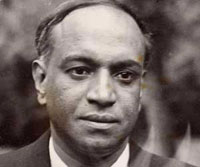
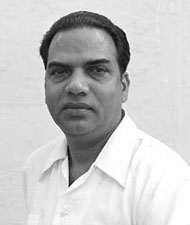
He was born on 1 October 1904 in Peralassery. By the time he became a teacher, India's independence movement was becoming energized by Mahatma Gandhi. Gopalan took part in the Khilafat Movement which prompted a marked change in his outlook, transforming him into a dedicated fulltime social and political worker.
In 1927 he joined the Indian National Congress and began playing an active role in the Khadi Movement and the upliftment of Harijans. He was arrested for participating in the salt satyagraha in 1930.
While in prison he got acquainted with communism and became a member of the Congress Socialist Party and later the Communist Party of India when it finally took shape in Kerala in 1939. He led the hunger march from Malabar region to Madras in 1937 and the Malabar march in support of the movement for responsible government in Travancore.
He was jailed in 1939, but escaped from the jail in 1942. When India got independence A.K.G was again in jail. He was elected to the Lok Sabha five times. He was the leader of the opposition in the Parliament. He was one among the 32 members who walked out of the CPI National council in 1964. He was the member of Polit Bureau.
AKG was married to Susheela Gopalan, who was a prominent Marxist and trade union activist. His daughter, Laila, is married to P. Karunakaran, the Member of Parliament for the Kasargode constituency.
AKG played an important role in the formation of Indian Coffee House, a worker cooperative initiative by organising the thrown out employees of Coffee Houses of Coffee Board to establish ICHs in late 1950s. His contribution is documented in Coffee Housinte Katha, a Malayalam alternative history book by Nadakkal parameswaran pillai the founder of ICHs in Kerala with the Communist Leader of Thrissur Advocate T. K. Krishnan.
A.K Gopalan died on 22 March 1977. His valiant struggles for protecting the interest of the working class inside and outside the Parliament earned him the title the “Crusader of the downtrodden”
Artist A.P. Achuthan's name is written in golden letters in the history of Thalassery. People in the new generation may not know much about him. He achieved fame both at National and International level as great puppet artist. Achuthan Master passed SSLC from Brennen High School. He started working as an art teacher. Lot of of people used to come and see the puppets he made and displayed. The Thachoti Udayanan and Kungi Puppet show even earned him a place in Times of India.
Achuthan Masters creations, a remote-controlled (auto-lady) lady was displayed at an International Exhibition in Delhi at 1959. But he did not get anything from his exhibition and he has to pay half of his income as tax. He has also created statues of Gandhiji, Nehur and Shri Narayana Guru. He was also earned fame for creating a statue for Yesudas.
His book of black board drawings which was printed at the Kannur Co-operative Press became a basic text for students of art. Thouhg he earned great fame he was never arrogant. He died on December 1980.
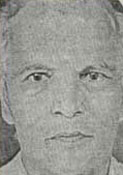

As the first Congress Chairman of Telicherry (now Thalassery) Municipality, he figures in prominence in the history of Thalassery. He also entered the annals of Indian history of post- Independence as a member of the Constituent Assembly. As a representative of the people he got the unique opportunity to develop Thalassery & to serve its people in the capacities as Municipal Counselor, Municipal Chairman, Member of Legislative Assembly & Member of Parliament.
He was a staunch follower of Sree Narayana guru’s teachings & Gandhian principles. He thus upheld honesty & integrity in all his dealings. With a height of 6 feet he could thus walk with his head upright with no occasion to bow it before any allegations of corruption, nepotism, or favoritism by his political opponents. He thus proved to be a role model in politics.
He was born on 13th May 1895 at Thalassery. His Father was ‘Ponnambath’ Kanaran, an ardent follower of Sree Narayana Guru who contributed for the construction of the JAGANATHA TEMPLE at Thalassery. His Mother Karinjutty belongs to the famous Mambally family, which started the bakery business in kerala. Shri Kunhiraman was educated at Kanakamadam west Eranjoli elementary school, Govt. Brennen College, Pachiappas College, & Law College Madras. He married Ondyan Nelliyatt Sharada & have 6 children.
He became Counselor of the Tellicherry Municipality in 1931 & was associated with Municipal Council till 1942. He was elected as Municipal Chairman in 1938. But resigned the chairmanship in Aug 1942 as a protest against incarceration of the Congress leaders for “QUIT INDIA” movement. A week after his resignation from chairmanship, he was arrested & kept as a detenu for 2 yers & 3 months. At the time of his arrest his wife was pregnant but Shri Kunhiraman did not ask for parole or even an interview during the period of his imprisonment. During the 25th year of Independence he was awarded “THAMRAPATRA”.
After Independence as member of constituent Assembly he became Member of Parliament & elected as a member of the Communication Transport Road Committee of Parliament. He voiced for the renovation & extension of Railway station at Thalassery. In 1952 he was elected again as Chairman of municipal council & continued till 1955. In 1960 he was elected as member of Kerala State Assembly & chosen as member of STA.
After split of Indian National Congress Shri. P.Kunhiraman concentrated in social works. He was a man of courageous convictions. He consistently stood for the right & just cause. Apart from being a good lawyer, he is a friend of poor, a reformer & guide. His honesty, sincerity, devotion & punctuality made many number of organizations to urge for his leadership to guide & lead them. He was the chairman of many organizations in the public field of Thalassery, namely After care home, Abala Mandir, Guild of Service, Victoria Library, Hindi Prajara Sabha, Sri Jnanodhaya Yogam, Kadhi Village Industries Exhibition Committee, Govt. Hospital Advisory Board, Abaya Niketan, Kannur Mahatma Mandir Construction Committee etc. In the education field he gave a pro-note to ensure that construction of Brennan College should not suffer due to shortage of fund to be given as public share. He supported prohibition & picketed Toddy shops. In the Malayalam Literary field he contributed short stories. A compilation of the short stories written by him was published in 1935.
He died on 18th June 1976. But the people of Thalassery still remember this noble soul, who devoted his life for them. In the Eid TV program of the year 2006 one Muslim lady was recollecting the efforts put in by him to arrange food for them during the Hindu-Muslim riot of 1970’s. In 1995 his memories were cherished by centenary celebrations. On the Republic Day of 2006 Telicherry Municipality honored him by giving his name to the road leading to the Civil Court.
It is 37 years since C.H. Kanaran passed away. When he died he was one of the greatest leaders of the Communist movement in Kerala. He was born in a poor family in Azhiyur. After passing his matriculation he has stopped his education for various reasons. During the freedom struggle he concentrated his activity in Thalassery.
He led the movement against foreign clothes in front of some foreign shops in Thalassery. He was arrested in 1932 for his struggle against imparity. After being freed from jail he spent some time for teaching. He then became a fulltime revolutinary and a congress worker. He organised farmers and beedi workers. Soon his activities spread all across Malabar. He led the beedi workers strike in 1937-39. He also became an Assembly member from Nadapuram. He was a great speaker. He was also know for his organising abilities. His war, without rest took his toll and he passed away at the age of 61.
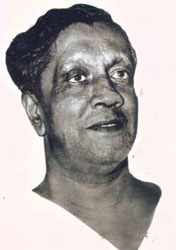
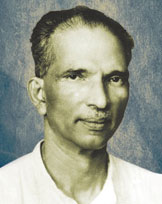
C.K. Govindan Nair who was also known as C.K.G, was the outstanding contribution of Thalassery to Kerala politics. He was committed to democratic principles and was a giant in both stature and size. Born in a landlord family, he still learned about the adverse effect of British rule on Indian Society. After doing his primary education he joined Brennen College. He became a student activist and was suspended from the College. He them left Thalassery and went to Madras where he studied at the Christian College and Pachayyappas college. After completing his law education he became attracted to Gandhiji and participated in the boycott of foreign clothes.
He met Gandhiji in 1933 and accompanied him to many places and the same year he became the Secretary of Malabar Congress Committee. In 1942 he was sent to jail for three years for participating in the Quit India Movement. He was also became the Member of the Madras Assembly from fighting the election from Quilandy in 1946. In 1950 he was elected for the KPCC and defeated K. Kellappan in the election to the President's post. When the congress split in 1952 and the Kisan Mazdoor Praja Party was formed. Kellappan and other joined that party. It was CKG and Kozhiporath Madhava Menon who ensured that congress remained strong despite the split. In the first Parliament election he fought against AKG in Kannur and lost. After EMS Namboodiripad became Chief Minister in 1957 Kerala witnessed a great struggle against communist. C.K.G was arrested under section 144.
CKG also started a newspaper called Janavani which resulted in a big loss. In 1960 he was selected KPCC President and rose to National fame. He was a favourite leader of Jawaharlal Nehru and he was also nominated for the Congress working committee. He also served as Director of the Indian Oil Corporation and Director Board Member of the Patriot Group of Newspapers. He died on June 27, 1964.
C.K. Revathi Amma belonged to a famous Thiyya family of Malabar. Revathi Amma, the daughter of Karayi Damayanthi was the grand daughter of the eminent merchant Karayi Bappu, who is said to have maintained trade relations with England. Revathy Amma's husband was the police commissioner of Mayyazhi and his uncle was the Mayor.
Her presence very much stamped on the political, social and communal spheres of Mayyazhi and Malabar. She started her public life attempting to emancipate the women in Mayyazhi. Her previous experiences as a social worker are often portrayed beautifully. She and her daughter contributed their ornaments to Gandhiji's Harijan Welfare Fund and he blessed them by placing his palm on their heads. Positions and fame sought after her as a social worker but she was mockingly nick-named as the 'stray goat of the bazar' by her own kith and kin. Thus she had to overcome so many severe tests of her times. In the background of an Anglo-French culture, she gained the status of a social worker and her life is amply revealed through her autobiography, Sahasrapoornima (completing thousands full moons).
The portrayal of herself as a daughter, wife, mother, and also as a social worker is done with much ease and grace. She pours into the readers the sweetness and bitterness of these real life roles. Her autobiography is an arduous outcome of twelve years' labour and she has an extraordinary view about its purpose.

C.K.P. Cheriya Mammukeyi is known as the Ironman of the Indian Union Muslim League. He was born in the ancient Keyi family on May 10, 1920.
Mammukeyi got involved in business and political activity from an early age. He was attracted to the Muslim League through Suttar Sait who later shifted to Pakistan. He played a major role in moulding several young leaders. He has served as the Vice-president of Muslim League and as Member of the Chandrika Director Board. He was even offered a post in the E.M.S. Ministry when M.P.M. Ahmed Kutty Kurikkal died but he politely refused. He has contributed a lot to the development of Thalassery. He was arrested and sent to jail during the liberation movement against the EMS ministry. He also went to jail 21 months during the emergency.
He died on June 9, 1994.
Artist C.V. Balan Nair believes that spirituality is the essence of all art. He also believes that fame and money can only make the artist arrogant. Balan Nair studied at Thalassery Brennen High School. He was more interested in art in school days. He used to use turmeric line, blue and plant colours to work on his paintings. He painted Theyyams, Bhagavathi and Kuttichatan and gift the paintings to his friends.
Balan Nair completed his school education with great difficulty because of the bad economic condition of his family. After his studies he learnt Kalaripayathu and used to perform at several Kalaris. He also read a lot of books on Swami Vivekananda. A meeting with artist M. Raman who established 'The Cochin School of Arts' was an eye openener for Balan Nair in 1925. He started using canvas for his paintings after this encounter.
Later, Balan Nair went to Thiruvananthapuram in 1930 where he created a lot of works with the help of Panambrath Kelappan who provided him food and lodging. In that period Sanjeyan became an associate of Balan Nair and they used to do outdoor paintings. Later Balan Nair returned to Thalassery where he taught little children art. He also started an art school.
In 1939 he was appointed Art Teacher in Thalassery Brennen High School. He married Thangamma in the same year. Children from various parts of Malabar used to come to study at the art school. With the death of his brothers Karunakaran Nair and Narayanan Nair the responsibility of taking care of the wives and children fell on Balan Nair. In accordance with the wishes of his brother, he also started Kalari displays at various places.
He conducted 120 Kalaris in the name of his brother Narayanan Nair in various places. In 1958, the silver jubilee of the Arts School was celebrated with great fervour. Balan Nair once travelled in Mumbai and Kolkatta and sold some of his paintings there. He also met Gemini Roy and learnt about his concepts. In 1962 he was selected as Member of Kerala Lalitkala Academy. After retiring from school he became the Principal of Kerala School of Arts. Today he is not an individual but an institution.
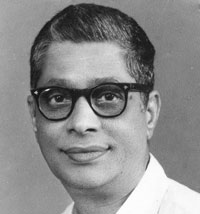
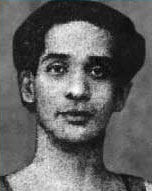
It was C.V. Narayanan Nair who re-established the glory of Kalaripayattu which was destroed by the British. The Kalaripayattu and Kalari fighters were a great threat to the British and their attempts to establish supremacy in India. Then collector of Malabar Robert Richards ordered that all villages be searched for Kalari fighters and all weapons be ceased. Kalari teachers were even sent into exile.
During the freedom struggle lathi cubs and wrestling centres were established as part of the efforts to revive indigenous martial art forms. THus Kalaripayattu made a rebirth at Thiruvangad Temple in Thalassery. The guru who led this revival was Kottaikal Kanara Gurukkal who belonged to the Chambadan veedu family of Thalassery. His great disciple was C.V. Raman Nair who was an accomplish fighter. There was also a Kalari display at the Congress meeting in Thalassery.
The Kerala Kalari Sangham led by him also presented shows in Karnataka, Tamilnadu, Mumbai and Delhi. He also established Kalaris in Mattanur, Kathirur, Cherpalassery and Tritala.
Sir C.P. Ramaswamy Iyer who was the Diwan of Travancore felicitated him when he presented Kalari before Maharaj of Travancore Shir Chithira Thirunal. THis Kerala Veerashri died early at the age of 38 on June 27, 1944.
Today kalari has spread to far shows and is popular in Europe and America. But very few people remember the role played by CVN in popularising Kalaripayattu.
Chemanjeri Kunjhiraman Nair was the king of the dance drama scene in Thalassery. He became famous through the Kathakali performances at the Kadathanad Kovilakam. He also worked for the progress of dance forms like Bharathanatyam. The Bharathiyanadu Kalalayam which he started at the Ladebeater Hall of the Thiruvangad Theosophical Society became the center of dance forms in North Kerala.
The musical dance dramas written by Shri Mehunath Kunjhikrishnan Nair and presented by Kunjhiraman Nair were a visual treat in North Kerala. Kunjhiraman Nair received the Kerala Sangeetha Nataka Academy award and remains in memories even today.
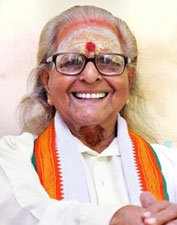
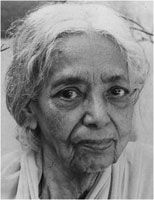
Dr. E.K. Janaki is a giant in the world of science. She obtained her Doctorate in Science from Michigan University and was also awarded the LLD at the same university for her brilliant contributions to research. She was shining light in the field of research in India and England. Dr. Janaki was the daughter of diwan E.K. Krishnan of Chettiamkunnu who was also a sub judge. She did her graduation and post graduation from Queen Maries college in Madras and then worked as Lecturer at Women's Christian College at Madras. After getting a Research Membership she went to Michigan University where she got a Doctorate in Science.
On her return she was appointed as Professor at the University College, Trivandrum at the age of 34. She later left the job and joined the Sugarcane Research Institute at Comibatore to engage in research. She created a new form of sugarcane called SG 6332 through breeding experiments which was very sweet. She presented her achievements at the Edimborough Geneticist Conference in 1939. The new breeds she created had now grown in our land.
Nehru met her in England and invited her to come to India. She agreed for it and was appointed as special officer in the Botanical Survey of India. The book "The Chormosam Atlas of Cultivated Plants' authored by her and Dr. Darlingten is still a reference book for the PhD Students.
She died while working at Maduravayal University Laboratory, Madras. She reamined unmarried as she felt family life would interfere with her research activity. In 1977 the Indian Government honoured her with Padmashri.
One of the comets which appear and disapper in the sky is named Bapu, Bork, Newkark, Comet. This comet is named after a great astro physicist from Thalassery who reached international fame. Dr. Vainu Bapu also served as Chairman of the World Astronomical Conference in USA and as President of the International Astronomy Union. He was also the director of Indian Institute of Astro Physics.
Dr. Vainu Bappu was born on August 10, 1927 as the only child of Manali Kukuzhi and Sunanna Bappu. He graduated in Physics from the Nazamia college in Hyderabad and after completing his post graduate studies joined Harward University to do research in Astro Physics. While studying Astrophysics a new comet came to his notice. The new comet was given his name and the name of two western Astrophysicists.
He was also awarded a doctorate by Harward university for his studies on "Wolfriot Group of Stars".
He later retured to India to work as Director of Banaras Observatory. He also wored at the Kaviyur Observatory in Tamilnadu. In 1986 the them Prime Minister Rajiv Gandhi named Kaviyur observatory after Dr. Bappu. He was also the recipient of Padmasri Award. He died in 1982 while preparing to participate in the 18th General Assembly of the International Astronomical Union.
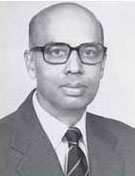
Eranholi Moosa is a prominent Mappila singer, hailing from Eranholi, Thalassery in Kannur district. He is well-known for many famous numbers like Manassinteyullil ninnu, Manikkya Malaraaya, Arimulla Punchiri and many others.
Moosa starred in the Malayalam movie, Gramaphone. He is one of the best known of the Mappilappattu. When he starts to sing in a stage program there will be big fans of him.
He got award for Mapila paatu from the Kerala Sangeetha Nataka Akademi in the year 2010.
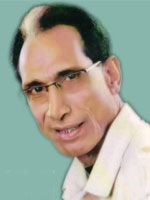
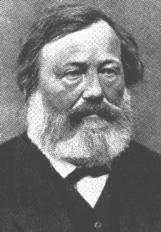
Dr. Herman Gundart who stayed at Illikkunnu for more than 20 years, is a pride of Thalassery. This German missionary who lived in Thalassery wrote the first English-Malayalam translator dictionary. He was born in Stuttgart on February 14, 1814 and came to India as a Christian missionary. He studied history and religion from Tubin University and got doctorate from Switzerland. In 1834 he become a member of Basal Mission. Basal Mission Society was his motivation for coming to India. He studied Hindi, Bengali and Tamil in early day itself.
From 27th February 1839 he started staying at Illikkunnu, a place near Thalassery-Anjarakkandy road. In 1939 he started a school in the Bungalow. He was the first school inspector for Malabar and South Karnataka. In 1847 first Malayalam news paper 'Rajyasamacharam' started from Thalassery.
Dr. Herman Gundert died on April 25 1893.
V.R. Krishna Iyer is not a mere Judge. He is known among the people as justice Krishna Iyer. His personality is beyond that of a Judge, he is a humanitarian and a social worker.
In 1948, when he was a practicing Advocate, Krishna Iyer was taken to preventive custody by the Madras Police. He was in Kannur Jail for one month. The charge against him was that he used the Court as a place for propagating political agenda.
He was a famous Advocate when he was elected as an MLA to the Legislative Assembly in 1957. EMS requested him to join his Cabinet. He was in the forefront to fight the civil cases against Landlords in Malabar and also the criminal cases in favour of the labour class.
V.R. Krishna Iyer was the minister for seven portfolios namely, Home, Law, Prison, Electricity, Irrigation, Social Welfare, Inland Water, in the first EMS led communist Government in Kerala which came to power in 1957 following the victory of the Communist Party of India. He was 42 years at that time and was the youngest minister in the first democratically elected popular communist Government in India. Only two persons from the first EMS cabinet are still alive-Justice Krishna Iyer and K.R. Gowri Amma.
Minister, V.R Krishna Iyer who contested the election without accepting the formal communist party symbol, slowly became unpopular with the party leaders and party cadre. He did not permit any political influence in the departments under his control.
The language of Justice V.R Krishna Iyer, a great Judge of the Supreme Court, a committed social reformer, a crusader against injustice and a leading light for all malayalis, has always attracted every one. His literary skills were evident even in his Judgements. In the language of his writings and speeches he maintains a level of literary beauty.
In 1975, in the election related case of Smt. Indira Gandhi, the then Prime Minister, Justice Krishna Iyer who was the Judge of the Supreme Court at that time refused to give the Judgement according to her interests. This led to promulgation of emergency in the country. That was how the black chapter in the history of modern india was scripted by Indira Gandhi.
Justice V.R.Krishna Iyer contested election again in 1987 after he retired as a Supreme Court Judge. He also contested as a presidential candidate. His friend and opponent candidate Sri R. Venkata Raman defeated him and became the President.
Though Krishna Iyer decided to lead his retired life at Ernakulam, he never forgot his relations with the Thalassery. He had a strong desire to raise Thalassery which lost its ancient glory, to a model town.
Thalassery is a place that has given birth to several famous personalities who have contributed to the fields of politics, literature, arts and sports. V.R. Krishna Iyer had formulated various plans for the development of Thalassery into a modern town and to restore its lost glory of the past.
His 100th birthday was celebrated in Kochi in November, 2014 and a number of programmes were organised by members of the legal fraternity, citizenry and his friends and well-wishers to felicitate him. He had been actively involved in social and political life after retirement, almost till a few weeks when ill-health and advancing age took their toll on him.
He died on 4 December 2014. The state was in attendance at his cremation with his two sons, with a gun salute.
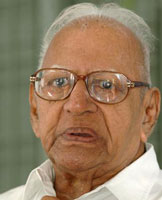
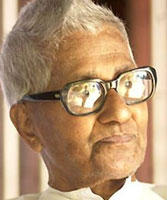
K. Raghavan Master is a Malayalam music composer. Along with Baburaj, Raghavan Master is often credited for the renaissance of Malayalam film music. He was born to folk singer M Krishnan and Narayani in Thalassery on 2 December 1913. He was influenced by the folk tunes while growing up in Thalassery. He joined All India Radio at Kozhikiode which had a circle of cultural people at that time.
K. Raghavan Master gave a new direction and identity to Malayalam film music. `Neelakkuyil,' released in 1954, gave Malayalam cinema a new direction and it also gave Malayalam film music an identity of its own.
He got Kerala State Film Award for best music director in the year 1973 & 1977. He got J.C. Daniel Lifetime Achievement Award from the Government of Kerala in the year 1997 and Lifetime achievement award from Asianet in the year 2000.
In 2010, India Government honoured him with Padma Shri for his distinguished contribution in music.
Some of his best songs include 'Kayalarikathu', 'Engane nee marakkum', 'kathu sookshichoru', 'Nalikerathinte nattil' etc.
He died at the age of 99 on 19 October 2013 in Thalassery.
K.M.Balakrishnan started his official carrier in Kerala State Revenue Department. He was a native of Thalassery. He played an important role in the implementation of the Land Reforms Act. While working as Additional Secretary, Land Board, he was appointed as Private Secretary to Health Minister, N.K. Balakrishnan. It was during this period, 'pay wards' were established in Thalassery Hospital, District hospitals and Medical colleges in Kerala. He had served as District Collector Calicut for a very long period. K.M.Balakrishnan who also made significant contribution to the Co-Operative Sector retired from his service as Registrar of Co-Operatives. After retirement, he also served as Managing Director of Kerala State Co-Operative bank.
The visit of Gadhiji to Thalassery created a lot of enthusiasm among freedom fighters. A lot of women came forward to court arrest. Among them was Kamala Bai Prabhu who was arrested and brought before a Joint Magistrate Court. She was senteced to 6 months imprisonment and Rs. 1,000 fine. Kamala Bai refused to pay the fine and instead removed her nose-ring and gave it to the magistrate. The magistrate was not satisfied and asked her to handover her mangalsutra. She told the magistrate that only the widows can remove the mangalsutra. The magistrate did not agree and asked the police to break the mangalsutra and hand it over. Left with no option kamal bai told a female friend to remove the mangalsutra and give it to the magistrate. She was then sent to the Vellore central jail.
The incident created a big controlversy. V.P. Narayanan Nambiar raised the issue in the Madras Assembly and S. Sathyamurthy took it up in the Parliament. The issue even came up in the British parliament. Mohammed Ismail, the advisor to the Madras goverment express regrets for the incident. He also ordered that the mangalsutra be returned to Kamala Bai but she refused to accept it. The magistrate Dodwell who created the mangalsutra controversy was sent back to Britain.
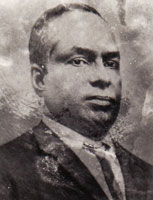
Keeleri Kunjhikkannan is popularly known as the father of Kerala Circus. He joined as a gymnastic teacher in B.E.M.P School.
The turning point was when Chatre’s Indian Circus came to Tellicherry and Keeleri met Chatre and a deal was struck. Keeleri would teach students gymnastic feats for circus and Chatre would employ them. It was in 1888 in the Pulambil area that the first lessons were given. The eminent students were Pariyali Kannan, Poovadan Kunjhambu and Poovadan Govindan.
It was in 1901 that he again started the circus training school at Chirakkara, Tellicherry. Pariyali Kannan, Irimban Kannari, Kunnath Yeshoda, Vendi Madhavi were his first students.
On February 2nd 1904 in Chirakkara the first circus company of Kerala, Parayalis Malabar Grand Circus was inaugurated. Unfortunately it could not continue and it had to wind up in 1906. It was in 1910 that he trained Kannan Bamboyo who later became a world renowned artiste.
In 1922 Keeleri’s nephew started the White Way Circus and in 1924 another disciple of his, Kallan Gopalan, started the Great Rayman Circus.
It was heard that he was so strong that he could even bend a coin
Shri Kodiyeri Balakrishnan, son of Shri. Kunjunni Kurup and Smt. Narayani Amma born at Thalassery on 16th November 1953.
Entered in politics while a student, was an active worker of SFI. He was State General Secretary of SFI from 1973 to 1979 and President, DYFI Kannur District Committee from 1980 to 1982. He was arrested under MISA and imprisoned for 16 months during Emergency. Elected to the Kerala Legislative Assembly on five occasions - 1982, 1987, 2001, 2006 and in 2011 from Thalassery constituency. He was Dy. Opposition Leader in 2001. He was Minister for Home and Tourism, Government of Kerala from 2006 to 2011.
He has been Secretary of the Communist Party of India (Marxist) Kerala State Committee since 2015.
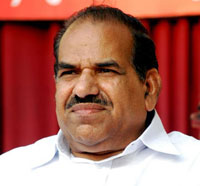
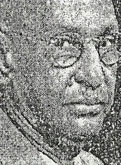
Anthropologist M.D. Raghavan who started the study of rural life in Kerala and earned international fame was a resident of Chettamkunnu in Thalassery. He completed his studies from Brennen College and Aloshia college in Mangalore and then started working as Curator in Egmore Museum in Madras. At this time he was selected for higher studies in Anthropology by Oxford University. On his return he was made a member of the Baronvon Iksarad Team, appointed to study about the tribals of Vayanad. He has also served as the Chairman of the Anthropology Wing in Madras University.
In 1946 he was appointed ethnologist by the Srilankan government. He studied the minorities in Srilanka and also served as the Chairman of the organisation formed for the betternment of Schedule Caste. He has also written several books including fok plays and dances of Kerala, Traditional arts of India and cultural change. He also studied the Chellath cave paintings in Thalassery.
Major General T Padmini born at Mannayad, Thalassery.
In 1967 she got the military nursing selection. After that she enrolled at the Indian Naval Hospital Ship (INHS) Ashwini in Mumbai.
After nearly four years of service, she chose to focus her attention on serving children. With this in mind, Ms. Padmini pursued a diploma in paediatric nursing in 1975, rendering the following 18 years of her service to children at the military hospitals in Pune, Kanpur, Delhi, Ahmedabad, and Chandigarh.
In 1992, Ms. Padmini underwent a course in hospital administration, making her the principal matron of the military hospitals all over India. She was promoted to the rank of Lieutenant-Colonel in 1993 and colonel in 2000, when she was working in Jammu.
The post of Deputy Director-General was the next she adorned while serving as hospital in-charge of the whole Western Command at Chandigarh. The highest rank of Major-General awaited her and she was posted at the Army Headquarters, Delhi, as the Additional Director-General.
Her long career in the Military Nursing Service made her the first woman Major-General from Malabar.
In 2009, she received the National Florence Nightingale Award from President Pratibha Patil. Later, she received the Sena Medal from the President for her distinguished services in the Indian Army.
from President Pratibha Patil in 2009.She has contributed towards awareness programmes aiming at safety of girl child, elderly care home and modernisation of military hospitals in the country. She is the first ever Nurse who has visited UN Mission hospitals at Congo and Lebanon to obtain first hand information on nursing care facilities provided to International clientele.
After her retirement in 2010, now she is working as a Nursing Director at Baby Memorial Hospital, Calicut.
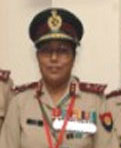
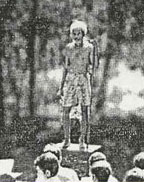
Students of the Kerala school of fine arts depend on life model Mammadka for their study of human anatomy. He receives a small payment for standing motionless before several students. Mammadka says that he is able to make his livelihood with this job and lot of students have drawn his body and learnt the art in the past 39 years. Lot of them remmber him with love and affection when they meet him.
Manayath Damodaran was a great bio-chemist who became famous at the National level. After doing his post graduation in Presidency college in Madras and Higher studies from Indian Institute of Science in Bangalore.
He conducted research in Germany and England and became Dr. M. Damodharan. He took charge of the Bio-chemistry department in the Presidency College. He also served as the Director of the National Chemical laboratory, Pune. His first project in science was "The Deterioration of Organic compounds due to micro organisms". He also conducted research in London University and earned the title of "Doctor of Science". His research papers in carbohydrate production and the Physical changes in Micro-organisms earned him fame in the national and international level.
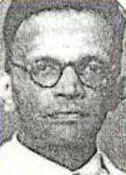
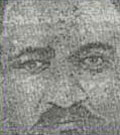
When the modiu bridge on the Thalassery-Kannur National Highway closed for 150 days for repair the hardship to the people was immense. It was then that they remembered the name of the bridge builder.
It was T.M. Moidu Sahib of the Thylakandy Mukkatill Tharavad who built this crucial link between Thalassery and Kannur. He went to Madras at an early age in connection with family business and started his own Timber company. He was attracted to social service and was elected as the Member of Madras Legislatve Council from Malabar Muslim Constituency in 1923.
He was also chosen President of the Malabar District Board by the government in 1931. He was honoured with the Khan Bahadur Shahib title. He was interested in constructing bridges and roads in his town. The bridge built near Dharmadam core was named Moidu Bridge by the British. Moidu Sahib died at the age of 51 in 1940. The bridge remains intact even today.
Kumaran Master was famous as a novelist, short story writer, poet, dramatist, critic and biographer. Above all he was a humorist and a famous Teacher. On those days in Malabar, the word Master was synonymous to Kumaran Master. He was also an educationalist and a member of Malabar Education Council.
He was a disciple of Sree Narayana Guru and has taken an important part in putting up a statue of Sree Narayana Guru at the premises of Jagannath Temple at Thalassery. He has worked as an editor for 12 newspapers. Language of Kumaran Master, who used to write in simple Malayalam was described as ‘marvelous’by A. R Raja Raja Varma. He was a brave community leader who won after taking up a lonely fight against the Thiyya leaders who opposed the entry of ‘pulayas’ into the Jagannath Temple, Thalassery.
He was one of the new age leaders of the Malayalam literature. He had more than 23 literary works to his credit. This includes novels like 'vasumati' and vellikkai, poems like 'markadasandesham, ilanchipoomala, ashakula, darshanamala, children's literary works like 'vaidyante anubavangal, sairandri, kunchachante kathakal. It was Moorkoth Kumaran who wrote the first biography of Sree Narayana Guru. He would be remembered as an eminent Editor, Teacher, Member of Muncipal Council, Public Speaker, Social Worker and also as the follower of Sree Naryana Guru.
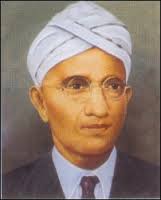
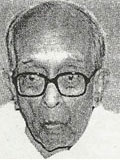
Murkoth Kunhappa was a bureaucrat-turned-journalist, born on May 14, 1905 as eldest son of Moorkoth Kumaran. Kunhappa who was a humorist had regularly contributed columns to all the news papers in Malayalam.
He was also an essayist like his father. He got awards for his works ‘Urulakkupperi’, ‘Kadalassinte Katha’, and ‘Moorkoth Kumaran’.
He has written a very famous English novel Three bags of gold and other Indian folk tales which is referred by many American universities as children's novel.
Moorkoth Kumaran’s second son Moorkoth Ramunni was the first keralite pilot who was selected to the Air Force during the Second World War.
He was also a good cricketer and a hockey player. He was against the castism that existed in the Kerala society at that time. It was Sree Narayana Guru's message that inspired him to fight against the inequalities in the society.
He worked as a Wing Commander on Burma Front. He also served in the Cabinet Secretariat of Jawaharlal Nehru representing the Air Force in the independent India. He had served in Nepal, Bangladesh, Lakshadweep, Nagaland etc. After retirement as an IAS officer, he changed his residence permanently to Dharmadam in Thalassery. He had written several articles in English and Malayalam. He was also Chairman of several committees.
He died on July 9, 2009 at the age of 95.
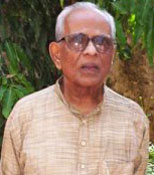
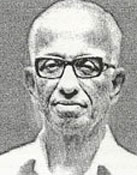
Moorkoth Kumaran’s youngest son Moorkoth Sreenivasan was a famous teacher. He was very good in teaching English Language and was a good elocutionist. He had written several articles and reviews on various poems and short stories. Mathruboomi weekly had published his poems and short stories.
He had served as teacher for 31 years in Kerala and Pondicherry and was a Head master for 24 years. He also worked as reporter of Hindu News Paper at Thalassery.
MV Devan, Born at Panniyannur, Thalassery in the year 1928. He was popularly known as Devan Master among artists and cultural activists in this part of the region, had been a familiar face in the art and cultural life of Thalassery till his age-related health condition worsened. He was the Secretary of Madras State Lalit Kala Academy and Art Consultant for FEDO (FACT), Honorary Director of Kerala Institute of Arts, Director of Kerala Kalagramam, the artists’ village in Mahe. He also served as Chairman, Kerala Lalit Kala Academy. He was awarded the Ravivarma Puraskar by the Government of Kerala and was also conferred the Mathrubhumi award.
He has executed murals for various hotels in Kerala. His collections are preserved in Dr. Sommerville collections UK, Asian Foundation, USA, FACT, Kerala and the Madras Christian College, Chennai. It was Devan Master who had given a new direction to the field of painting and sculpture in Kerala.
The artist and sculptor who made his mark in the field of illustration died on April 29, 2014.
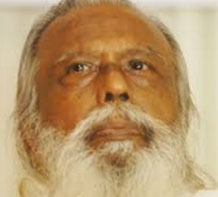
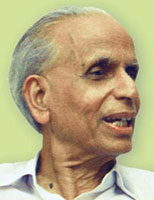
N.E. Balaram (Njalile Veettil Edavalathu Balaraman) was one of the founding leaders of the communist movement in Kerala, India. A Marxist ideologue, scholar in Indian Philosophy and a well known literary critic in Malayalam, he wrote on the history of the communist movement in Kerala, which is considered as the most authentic record of the early period. He also authored several works in History, Philosophy, Politics and Literature.
A lot of political leaders in India have neded their lives as Sanyasis. N.E. Balaram's story is the opposite. He became a sanskrit teacher at the age of 13 and wanted to become a sanyasi. But then this did not happen. Balaram participated in the formative meeting of the Communist Party in his locality, Pinarayi. He was beaten up and put in jails several times. He has written several books and has an excellent knowledge in English, Hindi, Malayalam, Tamil and Sanskrit. He also knew Bengali. He left us in his 74th year on July 16, 1994.
Shri Nettur P. Damodaran (14-05-1913 - 11-10-1978) was born to Shri K.P Kunhikannan and Smt. Thalu in Nettur, Thalassery. He was a member of the 1st Lok Sabha (1952) from the constituency of Tellicherry, which was part of the Madras state. Nettur P, as he was popularly known, had established his own image as a good Parliamentarian, journalist, philanthropist, reformer and writer.
He graduated in Physics from Madras Christian College and it was here that his public life started when he was elected as the first elected Student Union Chairman of the College council in 1935.
Shri. Nettur P Damodaran had for a brief period worked as a journalist, first in Free Press Journal and later for Mathrubhumi in Bombay as correspondent. He was also editor of 'Dinaprabha', a Malayalam daily published from Calicut in early 60s. From 1963-66, he held senior position in the Home ministry, Government of India, as Officer on Special Duty for the welfare of Scheduled Castes and Scheduled tribes, which gave him opportunity to travel extensively all over India. His experiences during these travels gave enough material for his literary incursion in the form of a travelogue - Narmadayude Naattil (In the land of Narmada). Several other travel experiences were published serially in Malayala Manorama weekly in late 60s. In 1967, he was appointed as the Chairman of Backward class reservation commission by the Left Democratic Front.
He was conferred with the honorary "Thamrapathra" on the Silver Jubilee of Indian Independence by the then Prime Minister Indira Gandhi(1972) in recognition of his sacrifices towards the independence struggle.
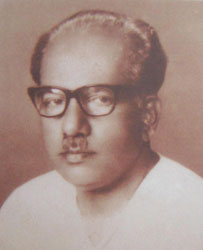

Oyyarathu Chandumenon born on 9 January 1847. He was a Malayalam novelist who wrote Indulekha in 1889, the first Malayalam fictional work which met with all the requisite characteristics typical of a novel according to a widely accepted Malayalam literary convention. It is not the first novel per se, as Kundalatha (a much inferior work) by Appu Nedungadi pre-dates it by a year.
Chandumenon got his English education at the school level. He began his career as a clerk in the government service. William Logan, author of the Malabar Manual appointed him as a clerk at Sub-Collector's office. Through a series of promotions, he became a municiff, and in 1892 became the sub-judge of Calicut.
He began a second novel named Sarada, the first part of which appeared in 1892. Chandumenon made important contributions as a social reformer. He was a member of the committee constituted to inquire and report on the Malabar Marriages Bill. His observations on matriliny among Nairs and polyandrous matrimony of Nair women that prevailed during the time are of historical importance. He was bestowed with the title of Rao Bahadur in 1898 for excellent service. Chandumenon died on 7 September 1899.
The puthiyaveetil Kunjhiraman was a great freedom fighter, trade union leader and politician. Despite being a freedom fighter he never applied for freedom fighters pension. He takes care of the accounts in some commercial establishments of Thalassery and meets the expenses of his family. During the Quit India Movement in 1942, Kunjhiraman who was an eigth standard student boycotted classes along with senior students like Tayat Shankaran and N.P. Govindan Nambiar.
In 1944 he joined the Royal Indian Navy and participlated in the Burma war. His ship attacked the apanese on the shores of the Iravady. Later his ship rescued a lot of people from Port Blair which was under Japanese occupation at that time. During the Naval mutiny in 1946, Kujnhiraman and few of his associates removed the Union Jack and hoisted the tricolour. Two of the importants events which pave the way for ndia's independence were Quit India Movement and Naval Mutiny.
Later Kunjhiraman reached Thalassery and participated in the freedom movement for Mahe. In August 1955, he led the team of the communist party from Malabar which participated in this struggle. He also organised the cashew workers. He did not enjoy any of the benefits which freedom fighters enjoy. He also remained away from power.

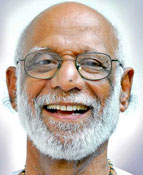
PS Karunakaran born in 1937 at Thalasserry, Kannur District, Kerala. Studied Fine Arts under the eminent artist Sri. C V Balan Nair. Attended courses in graphics and lithography at the College of Fine Arts, Madras.
He was the Principal of Kerala School of Arts, Thalassery for 32 years. He designed the exhibition gates for the All India Exihibition conducted by the Sharada Krishna Iyer Fine Arts Society. He got Puraskara Pathram for commendable work in the field of art by Kerala Chithrakala Parishath in 1996. He was honoured by the Lalithakala Academy in 2006 and as 'Renowned Artist' by Indian Medical association, Thalassery in 2003.
He died on 8th April 2015.
Pinarayi Vijayan was born on 21 March 1944 in Pinarayi, Thalassery. He is the Chief Minister of Kerala. He is an Indian politician and a member of the Politburo of the Communist Party of India (Marxist). He was General Secretary of the Kerala State Committee of the CPI(M) from 1998 to 2015.
After passing out of school, he worked as a handloom weaver for a year before joining for Pre – University course in the Government Brennen College, Thalassery. Later he completed degree course from there.
Pinarayi Vijayan entered politics through student union activities and eventually joined the Communist Party in 1964. He was president and secretary of the Kerala Student's Federation (KSF) and also served as the president of Kerala State Youth Federation (KSYF). He was elected to Kerala Legislative Assembly in 1970, 1977, 1991 and 1996. Served as minister in Kerala government between 1996 and 1998.
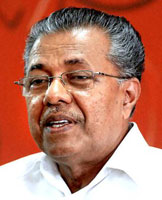
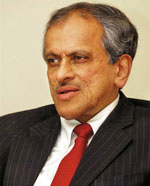
After Tetley, a British company merged with Tata Tea, Tata Tetlay Tea became the second largest tea company in the world. One of those who played a pivotal role in this achievement is R.K. Krishnakumar.
Krishnakumar is now Director in the 35,000 crore Tata sons which runs around 80 companies. He is the son of R.K. Sukumaran who was Police Commissioner in Madras and Sarojini who belongs to the Murkoth Tharavad in Thalassery. Krishnakumar joined the Tata Administrative service in 1963 after doing his B.A., course from Loyolla college in Madras and his Post Graduation in Presidency College. He has served as Vice-Chairman of Tata Tea, as chairman of Tata Coffee and as Director of Tata International. In 1997 he became the Managing Director of the Taj Group of Hotels.
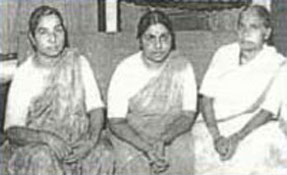
The sisters of the Vaidyar family in Thalassery are a shining example of revolutionary spirit at a time when the fire of freedom was raging in the minds of Indians. They were Suguna, Kamala and Swarna who were the daughters of Dr. Kunhikoru Vaidhyar and Panoli Manikoth Rohini. Dr. vaidhyar associated with the freedom struggle in 1930s when he was practising in Mumbai.
Kamala was at the forefront boycotting foreign goods and picketing liquor shops. When he was imprisoned Dr. Vadidhyar sent his diaughters to Kerala to lend strength to the freedom movement. Kamala who participlated along with Pothari Madhavan in the political movement in North Malabar was sent to jail for six months.
Her sister Swarna was also imprisoned for six months. The brave acts of the three sisters came in for praise from the great Kelappan. During the Guruvayoor Satyagraha AKG was arrested. Kamala was selected by the Satyagraphis to lead the movement. She later joined the trade union movement under S.A. Dange. While Kamala married Shankar Rao Kombrabale Swarna married industrialist Kayath Damodharan. Railway employee Kirshnan was Sugana's husband. The efforts of these three sisters are commendable as they came at a time women's participation was very less in the freedom movement.
The popular atirist of Malayalam Literature, Sanjayan was born at Othayoth house at Thiruvangad near Thalassery on June 13,1903. Sanjayan was his pen name and his real name was Manikkoth Ramunni Nair.
He was a Lecturer in Christian College, Kozhikode. His writings include anthology of poems like 'Adyopaharam', 'Hasyanjali'. He also wrote a collection of satirist essays. He was the editor of the magazine 'Viswaroopam'.
He is not only a great humourist but also a socio-political commentator who wrote with felicity on a wide range of subjects, that too in a language that sizzled with humour.
He died on September 13, 1943.
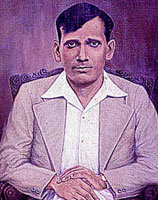
Sarada Krishna Iyer was born on 10th November 1925 in Devakottai to District Judge P.V. Parameshwar Iyer and Kamalabai Ammal. She had flair for music and for sport activities even as she was a student. She was married in January 1941 to V.R. Krishna Iyer who was then practicing as an Advocate. There is a saying that behind each man’s success there is a woman. This was true in the case of Justice V.R. Krishna Iyer. In his distinguished and dedicated career in the various fields of public service, she was his key supporter and a motivating factor.
She was a source of strength for her husband V.R. Krishna Iyer in his in his multi-faceted career as a distinguished Advocate, Politician, Administrator and Minister, Socially responsible judge and above all in his life as a Humanitarian. She was a great support to her husband and she used to associate in the election campaign for her husband. Sarada Krishna Iyer had been a gentle person, loving and lovable, a versatile genius, a patron of fine arts and sports, vivacious and happy-go-lucky.
She had served as a member of the Managing Committee of the Kerala Fine Arts Society and also as a Member of the Audition Committee of the All India Radio, Trivandrum and Delhi.
She had always been simply, elegantly and tastefully dressed. Style in her dressing depicted her character and mission in life- Simple, elegant and in harmony with her personality.
She had led women’s organisations to help affected people at the time of national emergencies, natural disasters and epidemics. She had also worked as a president of the Kerala branch of the ‘Dakshin Bharath Hindi Prachara Sabha’. She was an active worker of the Indo-Soviet Cultural Organisation and World Peace Organisation. She had also participated as a delegate in the world peace conference held at Stockholm in 1958. There are not many who have worked for the destitute women in Kerala like her. People can only remember her with gratitude for the social service she rendered in her life time.
Swami Vivekananda said that a person having qualities of truthfulness, dutifulness, and compassion can be called a good human being. In that sense, Smt. Sarada Krishna Iyer was a truly good human being. She was humane, compassionate and never got influenced by social and cultural barriers. She carried out social service silently. She would provide solutions to any problems posed to her. She was endowed with qualities of extra ordinary intelligence, energy and skills.
She firmly believed in the maxim ‘when thou doest alms, let not thy left hand know what thy right hand doeth’ She never wanted to take credit for the good deeds and she believed that no one should know her helping someone.
She was very much interested in playing shuttle cock and loved playing table tennis.
The destitute homes for the women at Thalassery and Ernakulam established for the protection of the downtrodden women, serves as a monument for her selfless service. She lives through them even today.
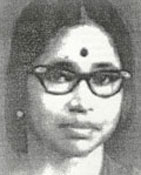
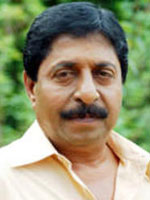
Sreenivasan is an Indian film actor and screenwriter known for his work in Malayalam cinema. He has written for over 50 films and has acted in over 200 films. He has also directed and produced two films each.
Sreenivasan was born in a small village of Patyam, to the east of Thalassery in Kannur, northern Kerala on april 4, 1953. His father Unni was a school teacher, an active Communist, and his mother Lakshmi, a homemaker. He completed his formal education in Government High School, Kathiroor and Pazhassi Raja N.S.S. College Mattannur. He did a diploma in film acting from the Film Chamber Institute, Madras in 1977 where Rajinikanth was his senior by a year.
Sreenivasan entered film industry in the 1977 P. A. Backer movie Manimuzhakam after finishing a course in acting from the Film Chamber Institute. In the film institute he was coached by the then vice principal A.Prabhakaran and later gave him a role in his movie Mela. A few movie roles later, he wrote his first film Odarathuammava Aalariyam in 1984. His most famous movies as actor-writer include Varavelppu, Gandhinagar 2nd Street, Nadodikkattu and its two sequels, Pattanapravesham and Akkare Akkare Akkare. He also made his mark as a director with his two award winning movies - Vadakku Nokki Yanthram and Chinthavishtayaya Shyamala.
Sreenivasan is married to Vimala and they have two sons. His elder son, Vineeth Sreenivasan, is a director, lyricist, singer, director, dubbing artist and actor. His younger son, Dhyan Sreenivasan, made his debut in Thira, a thriller movie directed by Vineeth Sreenivasan.
Subair was a Malayalam film actor. He had been part of Malayalam films for nearly two decades and has acted in around 200 films.
Subair was born in the village of Panoor in Kannur District, Kerala as the son of Sulaiman and Aysha.
Subair started his career in movies as a film producer at the age of 28. He produced a movie together with four of his friends, but unfortunately the movie was never released. His first movie as an actor was Bharatham in 1991 which followed by the 1992 movie Manthrikacheppu. His break came through the character Kadayadi Thambi in Lelam. The Tiger, Bharathchandran I.P.S. and Pathaka are his notable works. He has also acted in a mega tele-serial named Vamsham telecasted in DD Malayalam channel in 1994.
Subair died on August 18, 2010 due to a cardiac arrest. He is survived by wife Dilshad and two kids Aman and Amina Miya.
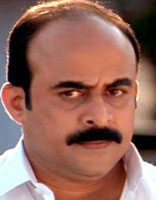
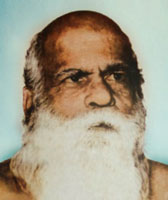
Swami Anandateerthan was a great social reformer who was even preapred to make the Harijans take up arms to fight discrimination. He followed the footsteps of Shri Narayana Guru and took off from where the Guru started. Swami Anandateerthan was born in Ananda Shenoy on God Saraswath family. He passed his B.A. Honours course with high marks and was attracted to the freedom struggle. As per the instructions of the Chakravarthi Rajagopalachair he joined the Shabari Ashram in Chavakad.
He was beaten up by Upper Caste Hidnus in 1927 when he led a group of lower caste children to a temple celebration near the Ashram. The Swami soon realised that caste and untouchability were the corner stones of Hindu religion. During a trip to Sabarmathi Ashram he reached a place in Ratnagiri in Maharashtra. The lower castes did not want to give him water as he belonged to an Upper caste and also discouraged him from drawing water form their well. The upper casts seeing him coming from a Harijan colony refused to give him water. FInally a muslim family gave shelter and food.
In 1928 Dharma theertha Swamigal got him a message from Shri Narayana Guru that he should reach Shivagiri as soon as possible. On August 3 Anandateerthan became the disciple of Shri Narayana Guru. He also received the Anandateerthan from Shri Narayana Guru. He was also the part of the rally led by AKG during the Guruvayur Satyagraha.
There are not many sanyasis in India who have been tortured like him. In 1934 Gandhiji visited his Ashram and planted a mango suppling which has became a big tree. In 1917 Anandateerthan visited the Durga Parameshwari Temple and was severely beaten up by upper caste youth. A friend resursed him when the youth went to fetch petrol to burn him. He also went on a strike demanding that a feast for only Brahmins in Guruvayur temple should be stopped. With caste discrimination continuing even today there is still the need for a lot of Anandateerthans.
Born on November 25, 1929 in a little village in Thalassery. Obtained diploma at the National College for Heating, Ventilating, Aircondition and Refrigeration in London in the year 1953-54. Thereafter employed at the works of Temperature Limited and other Air-condition and Refrigeration companies in London as Application and Systems Engineer.
He founded British Physical Laboratories (BPL) in 1963, during the Licence Raj, in Palakkad, Kerala, as a company for manufacturing hermetically sealed precision panel meters for the defence forces. BPL initially expanded its medical product ranges to include electrocardiographs and patient-monitoring systems. After the 1982 Asian Games, BPL expanded its range further and manufactured colour televisions and video cassette recorders, and later refrigerators, batteries and other consumer electrical equipment.
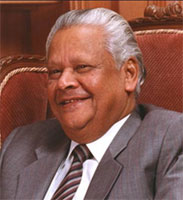

T. V. Chandran is an Indian film director, screenwriter, and actor, predominantly working in Malayalam cinema.
He was born (23 November 1950) in Thalassery to Narayanan Nambiar and Karthyayini Amma. TV Chandran worked as a Reserve Bank of India employee before entering into the film industry. He started his film career as an assistant director to P. A. Backer and John Abraham. He also acted the lead role in Backer's highly acclaimed political drama Kabani Nadi Chuvannappol (1975). He made his directorial debut with the unreleased feature Krishnan Kutty (1981), and followed this with the Tamil film Hemavin Kadhalargal (1985).
Chandran is widely regarded as one of the finest directors in Indian cinema and is widely credited with having revolutionised parallel cinema with his complex-structured art-house films. Chandran has won several film awards including six National Film Awards and ten Kerala State Film Awards. In addition to these, he is a recipient of a number of awards at various International film festivals.
Chandran has also directed a few tele-films and tele-serials. Notable among them are the tele-film Varum Varaykakal, which won the State TV Award for Second Best Tele-film, and the tele-serial, Sadasivante Kumbasaram.
Dr. T V N Nair was an eminent leader of the freedom movement in Indian history as well as a distinguished personality in the social, cultural and political arena of Thalassery. He paved the way for the freedom movement in North Malabar and Old Kottayam Taluk, with specific focus on Thalassery.
Hailing from the renowned "Thalassery Veedu" family, he has seven daughters and three sons. After completing his high school education in 1914, he obtained his L M P degree from Madras Medical College under the Military Scheme in 1918. Thereafter he joined the Military Service. During the First World War he served in the British Army. However he left the British Army, inspired by the charisma and ideology of Gandhiji to oust the British rule in India, and thereafter joined the independence movement, in 1922. Soon thereafter, Dr T V Nair began his medical practice in 1923 near the Thalassery Police Station.
In 1962 he moved his practice to a clinic on Logan's Road. His generosity towards his patients was legendary. In fact he used to cycle to patients' homes to treat them. His poorer patients seldom left without free medicines or money for food when they came for treatment.
When the spirit of the Indian freedom movement was being ignited by Mahatma Gandhi, Dr T V N Nair started spreading the fire of patriotism in Thalassery and surrounding areas. Dr T V N Nair contributed large sums of money to the Congress movement in Thalassery and served as the President of the Town Congress as well as that of Kottayam Taluk. He was arrested for participating with intense fervor in the 1932 non-violence movement.
In an era when Harijans were hated and shunned by the general public, Dr Nair was one of the few towering personalities who worked tirelessly and argued vociferously for alleviating the deprived Harijan community. During the days when Harijans were not permitted to enter the Sri Rama Swamy Temple in Thalassery, Dr Nair used to stand alongside the Harijans outside the temple premises and pray. Much later when this taboo was removed and Harijans joined the general public inside the temple, Dr Nair joined them inside to worship. His love and compassion for this community was clearly evident in one of his letters wherein he stated that he wished to be cremated at the Harijan burial ground.
In 1973 he was awarded the 'Thamara Patra' and a pension for his exemplary services to the freedom movement.
He died at the age of 88.
Velandi Achuthan is remembered by Thalassery for his excellent peformances in Basketball. He started his career as a volleyball player. When he realised that he could perform better in basketball he shifted to basketball. In 1955, he represented Madras University and for the first time the University won the National Tournament in which he played a significant part. After his studies he became a Physical Education teacher at Thalassery Mubarak High School. Many of those groomed by him in Mubarrak School became state level players. They include Rajendran, Rasheed, K.K. Mohammed and K.C. Ummar. He also functioned as the coach of the Kerala School Basketball Team for 23 years and was the chairman of the school basketball selection committee for twelve years.
Achuthan Master had a big role in the development of basketball in Kannur district. He was the coach of Kerala State School Teams which won gold and silver medals in National School games. He was a great player who represented State team in the Senior National. He along with Mr. Sam Joseph, National coach, attended the coaching camp conducted by American Coach Mr.Cofman in 1952.
Vineeth is an Indian film actor and classical dancer known for his works predominantly in Malayalam cinema and Tamil cinema. He was also starred in Telugu, Kannada and Bollywood films.
Vineeth is born ( 23rd August 1969) toAdvocate K.T.Radhakrishnan and Dr.Santhakumari. He has won prizes in Bharatanatyam, Mohiniyattom, folk dance, mono act and English resitation while he was studying in St. Joseph's Boys' High School. He won first prize for bharatanatyam dance at the state youth festival four years continuously. He pursued bachelors in commerce from Madras University in 1991.
As a dancer he has visited various countries like Gemany, England, France, Netherland including seven Gulf countries. He came to the film field while studying in Xth standard at St. Joseph's Boys' High School. His films like Nakhakshathangal, Kamaladhalam, Sargam etc are ever memorable.
His latest films are kumbasaram and 100 days of love.
Vineeth married Priscilla Menon and lives in Chennai . They have a daughter named Avanthi Vineeth.
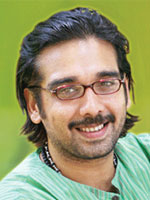
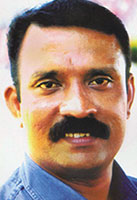
Vatta Parambath Sathyan, known popularly as V.P Sathyan was born in April 29, 1965. His parents were Vatta Parambath Gopalan Nair and Narayani Amma. He was married to Anitha and had a daughter, Athira.
He was a captain of the India national football team.
An Assistant Manager with the Indian Bank football team, Sathyan had served the bank since 1995, initially as a player and then as the team's coach from 2002.
A centre back, Sathyan started his career in 1983 representing Kerala in the Santosh Trophy National championship. He attended the South Zone camp for Indian probables under Amar Bahadur in 1985. Strongly built and a capable defender, he did enough to get into the National team to the 1985 SAF Games in Dhaka.
It was in 1986 that his career began to flourish as he represented the country in the Nehru Cup in Thiruvananthapuram and the Seoul Asian Games.
The late eighties brought forth some of his glorious moments. Sathyan's exploits with the once formidable Kerala Police team are well documented in the Indian football's history. From Kerala Police, he went to Mohun Bagan in 1992-93 for two seasons before returning to Kerala Police again and then moving over to Indian Bank.
Sathyan became the captain of the Indian team in 1991 for the World Cup qualifiers in Beirut and Seoul Sathyan was adjudged the AIFF player of the year in 1995, and that perhaps was the highest recognition for this largely unsung hero of Indian football. He had begun to make a mark in coaching, and was assistant to Stephen Constantine in 2002 when India toured South Korea.
Due to financial problems he committed suicide by jumping in front of a train in Chennai on July 18, 2006.